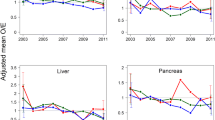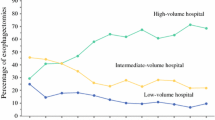Abstract
Background
The association between procedure volume and clinical outcomes has led many to advocate centralization of cancer procedures at high-volume centers (HVCs). Regional studies show practice patterns changing with increasing centralization of esophageal and pancreatic procedures at HVCs but little change for colorectal procedures. We hypothesize that similar trends are occurring nationwide.
Methods
Secondary data analysis was performed by means of the National Inpatient Sample. We examined trends in hospital procedure volume from 1999 to 2007 for all extirpative esophageal, pancreatic, and colorectal cancer procedures. Survey-weighted multivariate logistic regressions were used to examine the likelihood of surgery at a low-volume center (LVC) over time as well as to determine sociodemographic factors associated with surgery at LVCs.
Results
A total of 351,164 cases met the inclusion criteria (6,345 esophagus, 17,658 pancreas, 255,753 colon, 71,408 rectum). The likelihood of surgery at a LVC in 2007 compared to 1999 was as follows: esophagus odds ratio [OR] 0.42 (95% confidence interval [95% CI], 0.34, 0.53), pancreas OR 0.40 (95% CI, 0.35, 0.46), colon OR 0.88 (95% CI, 0.85, 0.91), rectum OR 0.83 (95% CI, 0.78, 0.89). Admission through an emergency department was associated with a higher likelihood of surgery at a LVC, even after adjusting for clinical and sociodemographic factors. Volume was also associated with race and payer; black patients and the uninsured were particularly likely to remain at LVCs.
Conclusions
Practice patterns have changed substantially to follow national recommendations for centralization of complex cancer surgery. Despite this, disparities remain with regard to access to HVCs.



Similar content being viewed by others
References
Birkmeyer JD, Siewers AE, Finlayson EV, et al. Hospital volume and surgical mortality in the United States. N Engl J Med. 2002;346:1128–37.
Begg CB, Cramer LD, Hoskins WJ, et al. Impact of hospital volume on operative mortality for major cancer surgery. JAMA. 1998;280:1747–51.
Birkmeyer JD, Sun Y, Wong SL, et al. Hospital volume and late survival after cancer surgery. Ann Surg. 2007;245:777–83.
Dudley RA, Johansen KL, Brand R, et al. Selective referral to high-volume hospitals: estimating potentially avoidable deaths. JAMA. 2000;283:1159–66.
Gruen RL, Pitt V, Green S, et al. The effect of provider case volume on cancer mortality: systematic review and meta-analysis. CA Cancer J Clin. 2009;59:192–211.
Hillner BE, Smith TJ, Desch CE. Hospital and physician volume or specialization and outcomes in cancer treatment: importance in quality of cancer care. J Clin Oncol. 2000;18:2327–40.
Hollenbeck BK, Dunn RL, Miller DC, et al. Volume-based referral for cancer surgery: informing the debate. J Clin Oncol. 2007;25:91–6.
Hewitt M, Petitti D. Interpreting the volume-outcome relationship in the context of cancer care. Washington, DC: National Academies Press; 2001.
Evidence Based Hospital Referral. Washington, DC: Leapfrog Group c/o Academy Health; 2008.
Riall TS, Eschbach KA, Townsend CM Jr, et al. Trends and disparities in regionalization of pancreatic resection. J Gastrointest Surg. 2007;11:1242–51.
Ho V, Heslin MJ, Yun H, et al. Trends in hospital and surgeon volume and operative mortality for cancer surgery. Ann Surg Oncol. 2006;13:851–8.
Stitzenberg KB, Sigurdson ER, Egleston BL, et al. Centralization of cancer surgery: implications for patient access to optimal care. J Clin Oncol. 2009;27:4671–8.
Gasper WJ, Glidden DV, Jin C, et al. Has recognition of the relationship between mortality rates and hospital volume for major cancer surgery in California made a difference?: A follow-up analysis of another decade. Ann Surg. 2009;250:472–83.
Steiner C, Elixhauser A, Schnaier J. The healthcare cost and utilization project: an overview. Eff Clin Pract. 2002;5:143–51.
Luft HS, Bunker JP, Enthoven AC. Should operations be regionalized? The empirical relation between surgical volume and mortality. N Engl J Med. 1979;301:1364–9.
Bailie K, Dobie I, Kirk S, et al. Survival after breast cancer treatment: the impact of provider volume. J Eval Clin Pract. 2007;13:749–57.
Barbieri CE, Lee B, Cookson MS, et al. Association of procedure volume with radical cystectomy outcomes in a nationwide database. J Urol. 2007;178:1418–21.
Barocas DA, Mitchell R, Chang SS, et al. Impact of surgeon and hospital volume on outcomes of radical prostatectomy. Urol Oncol. 2010;28: 243–50.
Billingsley KG, Morris AM, Dominitz JA, et al. Surgeon and hospital characteristics as predictors of major adverse outcomes following colon cancer surgery: understanding the volume-outcome relationship. Arch Surg. 2007;142:23–31.
Birkmeyer JD, Warshaw AL, Finlayson SR, et al. Relationship between hospital volume and late survival after pancreaticoduodenectomy. Surgery. 1999;126:178–83.
Bristow RE, Puri I, Diaz-Montes TP, et al. Analysis of contemporary trends in access to high-volume ovarian cancer surgical care. Ann Surg Oncol. 2009;16:3422–30.
Chen CS, Liu TC, Lin HC, et al. Does high surgeon and hospital surgical volume raise the five-year survival rate for breast cancer? A population-based study. Breast Cancer Res Treat. 2008;110:349–56.
Cheung MC, Hamilton K, Sherman R, et al. Impact of teaching facility status and high-volume centers on outcomes for lung cancer resection: an examination of 13,469 surgical patients. Ann Surg Oncol. 2009;16:3–13.
Cheung MC, Koniaris LG, Perez EA, et al. Impact of hospital volume on surgical outcome for head and neck cancer. Ann Surg Oncol. 2009;16:1001–9.
Dimick JB, Cowan JA Jr, Upchurch GR Jr, et al. Hospital volume and surgical outcomes for elderly patients with colorectal cancer in the United States. J Surg Res. 2003;114:50–6.
Enzinger PC, Benedetti JK, Meyerhardt JA, et al. Impact of hospital volume on recurrence and survival after surgery for gastric cancer. Ann Surg. 2007;245:426–34.
Fong Y, Gonen M, Rubin D, et al. Long-term survival is superior after resection for cancer in high-volume centers. Ann Surg. 2005;242:540–4.
Glasgow RE, Mulvihill SJ. Hospital volume influences outcome in patients undergoing pancreatic resection for cancer. West J Med. 1996;165:294–300.
Gutierrez JC, Perez EA, Moffat FL, et al. Should soft tissue sarcomas be treated at high-volume centers? An analysis of 4205 patients. Ann Surg. 2007;245:952–8.
Kovalic JJ, Perez CA, Grigsby PW, et al. The effect of volume of disease in patients with carcinoma of the uterine cervix. Int J Radiat Oncol Biol Phys. 1991;21:905–10.
Lin CC, Lin HC. Effects of surgeon and hospital volume on 5-year survival rates following oral cancer resections: the experience of an Asian country. Surgery. 2008;143:343–51.
Mitchell RE, Lee BT, Cookson MS, et al. Radical nephrectomy surgical outcomes in the University HealthSystem Consortium Data Base: Impact of hospital case volume, hospital size, and geographic location on 40,000 patients. Cancer. 2009;115:2447–52.
Ptok H, Marusch F, Kuhn R, et al. Influence of hospital volume on the frequency of abdominoperineal resection and long-term oncological outcomes in low rectal cancer. Eur J Surg Oncol. 2007;33:854–61.
Salz T, Sandler RS. The effect of hospital and surgeon volume on outcomes for rectal cancer surgery. Clin Gastroenterol Hepatol. 2008;6:1185–93.
Schrag D, Cramer LD, Bach PB, et al. Influence of hospital procedure volume on outcomes following surgery for colon cancer. JAMA. 2000;284:3028–35.
Schrag D, Panageas KS, Riedel E, et al. Hospital and surgeon procedure volume as predictors of outcome following rectal cancer resection. Ann Surg. 2002;236:583–92.
Effective health care: hospital volume and health care outcomes, costs and patient access. NHS Centre for Reviews and Dissemination 1996;2:1–14.
Hogan AM, Kennelly R, Winter DC. Volume-outcome analysis in rectal cancer: a plea for enquiry, evidence and evolution. Eur J Surg Oncol. 2009;35:111–2.
Kressner M, Bohe M, Cedermark B, et al. The impact of hospital volume on surgical outcome in patients with rectal cancer. Dis Colon Rectum. 2009;52:1542–9.
McGrath DR, Leong DC, Gibberd R, et al. Surgeon and hospital volume and the management of colorectal cancer patients in Australia. ANZ J Surg. 2005;75:901–10.
Hodgson DC, Zhang W, Zaslavsky AM, et al. Relation of hospital volume to colostomy rates and survival for patients with rectal cancer. J Natl Cancer Inst. 2003;95:708–16.
Truong C, Wong JH, Lum SS, et al. The impact of hospital volume on the number of nodes retrieved and outcome in colorectal cancer. Am Surg. 2008;74:944–7.
Liu JH, Zingmond DS, McGory ML, et al. Disparities in the utilization of high-volume hospitals for complex surgery. JAMA. 2006;296:1973–80.
Gray BH, Schlesinger M, Siegfried SM, et al. Racial and ethnic disparities in the use of high-volume hospitals. Inquiry. 2009;46:322–38.
Acknowledgment
Supported in part by NIH P30 CA 043703.
Author information
Authors and Affiliations
Corresponding author
Rights and permissions
About this article
Cite this article
Stitzenberg, K.B., Meropol, N.J. Trends in Centralization of Cancer Surgery. Ann Surg Oncol 17, 2824–2831 (2010). https://doi.org/10.1245/s10434-010-1159-0
Received:
Published:
Issue Date:
DOI: https://doi.org/10.1245/s10434-010-1159-0




